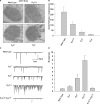Drosophila photoreceptors and signaling mechanisms
- PMID: 19623243
- PMCID: PMC2701675
- DOI: 10.3389/neuro.03.002.2009
Drosophila photoreceptors and signaling mechanisms
Abstract
Fly eyes have been a useful biological system in which fundamental principles of sensory signaling have been elucidated. The physiological optics of the fly compound eye, which was discovered in the Musca, Calliphora and Drosophila flies, has been widely exploited in pioneering genetic and developmental studies. The detailed photochemical cycle of bistable photopigments has been elucidated in Drosophila using the genetic approach. Studies of Drosophila phototransduction using the genetic approach have led to the discovery of novel proteins crucial to many biological processes. A notable example is the discovery of the inactivation no afterpotential D scaffold protein, which binds the light-activated channel, its activator the phospholipase C and it regulator protein kinase C. An additional protein discovered in the Drosophila eye is the light-activated channel transient receptor potential (TRP), the founding member of the diverse and widely spread TRP channel superfamily. The fly eye has thus played a major role in the molecular identification of processes and proteins with prime importance.
Keywords: G-protein; INAD scaffold protein; TRP channels; bistable pigments; optics of compound eyes; phosphoinositide cycle; phospholipase C; phosphorylated arrestin.
Figures











Similar articles
-
The light-activated TRP channel: the founding member of the TRP channel superfamily.J Neurogenet. 2022 Mar-Jun;36(2-3):55-64. doi: 10.1080/01677063.2022.2121824. Epub 2022 Oct 10. J Neurogenet. 2022. PMID: 36217603
-
The Drosophila light-activated TRP and TRPL channels - Targets of the phosphoinositide signaling cascade.Prog Retin Eye Res. 2018 Sep;66:200-219. doi: 10.1016/j.preteyeres.2018.05.001. Epub 2018 May 5. Prog Retin Eye Res. 2018. PMID: 29738822 Review.
-
Anchoring TRP to the INAD macromolecular complex requires the last 14 residues in its carboxyl terminus.J Neurochem. 2008 Mar;104(6):1526-35. doi: 10.1111/j.1471-4159.2007.05096.x. Epub 2007 Nov 22. J Neurochem. 2008. PMID: 18036153 Free PMC article.
-
The transient receptor potential protein (Trp), a putative store-operated Ca2+ channel essential for phosphoinositide-mediated photoreception, forms a signaling complex with NorpA, InaC and InaD.EMBO J. 1996 Dec 16;15(24):7036-45. EMBO J. 1996. PMID: 9003779 Free PMC article.
-
TRP Channels in Vision.In: Emir TLR, editor. Neurobiology of TRP Channels. Boca Raton (FL): CRC Press/Taylor & Francis; 2017. Chapter 3. In: Emir TLR, editor. Neurobiology of TRP Channels. Boca Raton (FL): CRC Press/Taylor & Francis; 2017. Chapter 3. PMID: 29356484 Free Books & Documents. Review.
Cited by
-
Systematic assessment of transcriptomic and metabolic reprogramming by blue light exposure coupled with aging.PNAS Nexus. 2023 Dec 5;2(12):pgad390. doi: 10.1093/pnasnexus/pgad390. eCollection 2023 Dec. PNAS Nexus. 2023. PMID: 38059264 Free PMC article.
-
Nematostella vectensis exemplifies the exceptional expansion and diversity of opsins in the eyeless Hexacorallia.Evodevo. 2023 Sep 21;14(1):14. doi: 10.1186/s13227-023-00218-8. Evodevo. 2023. PMID: 37735470 Free PMC article.
-
Genome-wide profiling of diel and circadian gene expression in the malaria vector Anopheles gambiae.Proc Natl Acad Sci U S A. 2011 Aug 9;108(32):E421-30. doi: 10.1073/pnas.1100584108. Epub 2011 Jun 29. Proc Natl Acad Sci U S A. 2011. PMID: 21715657 Free PMC article.
-
Ectopic Expression of Mouse Melanopsin in Drosophila Photoreceptors Reveals Fast Response Kinetics and Persistent Dark Excitation.J Biol Chem. 2017 Mar 3;292(9):3624-3636. doi: 10.1074/jbc.M116.754770. Epub 2017 Jan 24. J Biol Chem. 2017. PMID: 28119450 Free PMC article.
-
Prominosomes - a particular class of extracellular vesicles containing prominin-1/CD133?J Nanobiotechnology. 2025 Jan 29;23(1):61. doi: 10.1186/s12951-025-03102-w. J Nanobiotechnology. 2025. PMID: 39881297 Free PMC article. Review.
References
-
- Adamski F. M., Zhu M. Y., Bahiraei F., Shieh B. H. (1998). Interaction of eye protein kinase C and INAD in Drosophila. Localization of binding domains and electrophysiological characterization of a loss of association in transgenic flies. J. Biol. Chem. 273, 17713–1771910.1074/jbc.273.28.17713 - DOI - PubMed
Grants and funding
LinkOut - more resources
Full Text Sources
Molecular Biology Databases

